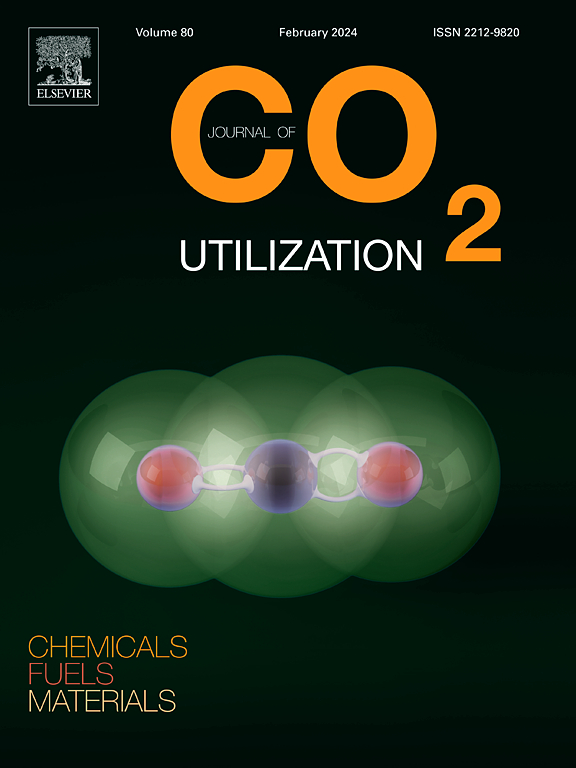Solvent-free valorization of sugarcane bagasse fibers into nitrogen-doped microporous carbons: Efficient contenders for selective carbon dioxide capture
IF 7.2
2区 工程技术
Q1 CHEMISTRY, MULTIDISCIPLINARY
引用次数: 0
Abstract
Nitrogen-doped porous carbons have been widely explored for CO₂ storage and separation, but expensive precursors and intricate synthetic approaches often limit their practical deployment. Here, we report a facile, one-step, solvent-free method to design nitrogen-doped microporous carbons (SBF-BC-KMx) for efficient CO₂ capture from sugarcane bagasse fibers (SBF) as a low-cost precursor. Melamine and KOH were used as a nitrogen-doping source and an activator, respectively. The specimen (SBF-BC-KM0.5), prepared with optimized melamine loading, possessed efficient textural features, including a specific surface area (SSA) of 1138 m² g⁻¹ , a micropore volume of 0.396 cm³ g⁻¹ , high concentration of ultra-micropores (<0.6 nm) (89 %) and high content of pyrrolic-N functionality (35 %). These properties enhanced the CO₂ capture performance, achieving 244.4 mg g⁻¹ at 273 K, 170.0 mg g⁻¹ at 293 K and 1 bar, and 351.5 mg g⁻¹ at 293 K and 10 bar. The optimized material exhibited a moderate isosteric heat of adsorption and an effective CO₂/N₂ selectivity at 293 K. The high ultra-micropore density significantly boosted CO₂ uptake and maintained stable CO₂ uptake over five adsorption cycles. Overall, this work devoted efforts to sustainable environment, biowaste management, and possible practical applicability of designed adsorbent for CO2 storage.
蔗渣纤维无溶剂增值成氮掺杂微孔碳:选择性二氧化碳捕获的有效竞争者
氮掺杂多孔碳已被广泛用于CO₂的储存和分离,但昂贵的前体和复杂的合成方法往往限制了它们的实际应用。在这里,我们报告了一种简单,一步,无溶剂的方法来设计氮掺杂微孔碳(SBF- bc - kmx),用于从甘蔗甘蔗渣纤维(SBF)中高效捕获CO 2作为低成本前驱体。以三聚氰胺为氮掺杂源,以KOH为活化剂。经优化的三聚氰胺负载制备的样品(SBF-BC-KM0.5)具有高效的结构特征,包括比表面积(SSA)为1138 m²g⁻¹ ,微孔体积为0.396 cm³ g⁻¹ ,超微孔浓度(<0.6 nm)(89 %)和高含量的pyropr - n功能(35 %)。这些属性增强公司₂捕获性能,实现244.4 毫克 g⁻¹ 273 K, 170.0 毫克 g⁻¹ 在293 K和1 酒吧,和351.5 mg g⁻¹ 293 10 K和 酒吧。优化后的材料在293 K下具有中等等容吸附热和有效的CO₂/N₂选择性。高的超微孔密度显著提高了CO₂的吸收率,并在5个吸附循环中保持稳定的CO₂吸收率。总体而言,本工作致力于可持续环境,生物废物管理以及所设计的吸附剂在二氧化碳储存中的实际应用。
本文章由计算机程序翻译,如有差异,请以英文原文为准。
求助全文
约1分钟内获得全文
求助全文
来源期刊

Journal of CO2 Utilization
CHEMISTRY, MULTIDISCIPLINARY-ENGINEERING, CHEMICAL
CiteScore
13.90
自引率
10.40%
发文量
406
审稿时长
2.8 months
期刊介绍:
The Journal of CO2 Utilization offers a single, multi-disciplinary, scholarly platform for the exchange of novel research in the field of CO2 re-use for scientists and engineers in chemicals, fuels and materials.
The emphasis is on the dissemination of leading-edge research from basic science to the development of new processes, technologies and applications.
The Journal of CO2 Utilization publishes original peer-reviewed research papers, reviews, and short communications, including experimental and theoretical work, and analytical models and simulations.
 求助内容:
求助内容: 应助结果提醒方式:
应助结果提醒方式:


